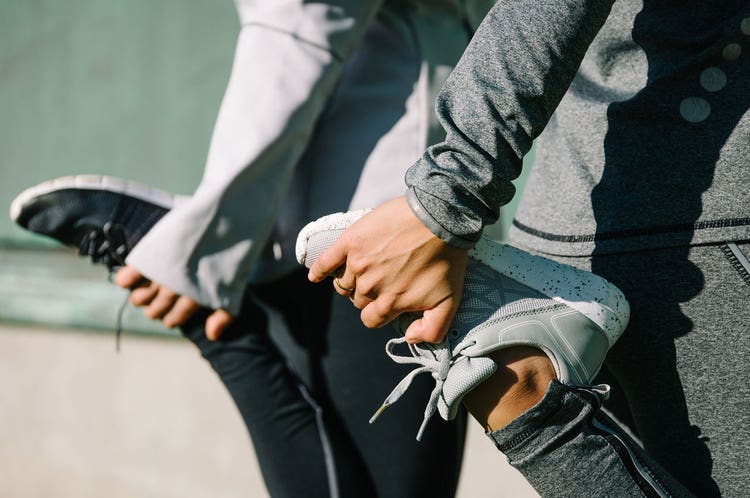Sneak Attack

The right pair of sneakers is the foundation of your workout.
Consider all the ways you’ve tried to boost your performance as an athlete. Maybe you’ve been hitting the weights extra hard, doing sprints, or taking yoga classes to boost flexibility. But there’s one simple solution you may have overlooked: great sneakers. Finding the right pair of athletic shoes that are ideal for your body and fitness routine is crucial. Below experts share exactly how to select the best shoe.
1. Get the perfect fit
“The most common mistake people make when buying running shoes is not getting properly fit,” says Nick Hemmer, Brooks Footwear merchandising manager. “Anyone looking for a new running shoe should head to a local running shoe store and get fitted by an expert. This will ensure you’re running in a shoe that works best for your unique body.” If you don’t have access to a running store, though, Brooks offers a Run Signature shoe finder on its website that walks you through a series of short questions and exercises to help guide you in the decision-making process.
2. Try before you buy
Don’t just go with the first pair of shoes you put on—test out a few and see what works best. “Start with your general size, then trust your feet—and don’t be afraid to try different sizes,” advises Tal Short, senior product manager at Reebok Performance Footwear. “What I mean is that a size 9 running shoe can fit differently than another style size 9 running shoe, even from the same company. There are so many factors that can change how a shoe feels to you—construction, materials, last shapes, foot shape—that your ‘size’ should be just the starting point.”
3. Listen to your sole
Feet are like snowflakes—they’re all unique, and you should especially keep that in mind if you have flat feet or high arches. “Depending on the severity of flatness or arch in your foot, you may need orthotics,” Short reveals. “Almost all modern, mass-produced shoes try to fit the most people possible, so if you are on either end of that spectrum, it’s unlikely to find a shoe that fits perfectly.”
4. Do your homework
“The most common mistake people make when buying sneakers is not doing any research and going into the store without any idea of what they want or need,” Short says. Consider what you’ll be using them for, how your body moves, and which qualities you need in a shoe. “Generally comfort, fit and a cushioning platform that you like are probably at the top of the list,” remarks Short.
5. Shop for your sport
Typically, you’ll need a good pair of cross trainers if you’re doing a mix of classes and activities at the gym. But you’ll want to round out your sneaker wardrobe for other activities. “Buying a pair of shoes that is specifically designed for a sport will improve your performance and reduce the possibility of injury,” says Brian Keating, vice president of product at K-Swiss. “True performance sneakers are really designed and engineered for specific sports.”
He continues, “Running, as an example, is a linear activity, meaning you go in only one direction: forward. Because of this, designers can focus on making the shoes lightweight, flexible and cushioned, and they can sacrifice lateral support or durability to achieve the best performance. These features make a great running shoe, but if you try to play tennis in them, they will perform poorly.”
6. Put shoes in rotation
“If rotating your running shoes is an option, it’s definitely a great way to prolong their life,” Hemmer suggests. “Rotating your sneakers also provides you with the option of mixing up your running experience. Having more than one running shoe in your rotation helps you work a slightly different set of muscles in your feet, helping you strengthen your feet.”
7. Keep it clean
Wipe your kicks with soap and water for basic spot cleaning. “Unless they say machine washable, I don’t recommend putting them in the washing machine or especially the dryer,” says Keating. “The high heat of the dryer can damage the foams and cements and, depending on the materials the shoe is made of, can actually shrink the shoes; it is better to let your sneakers air dry. Personally, I have found that a Mr. Clean Magic Eraser works wonders on a dirty pair of shoes.”
8. Know when to let go
“Replacing your running shoes will help eliminate injury and potential aches and pains that are caused by worn-out shoes,” Hemmer says. “As a shoe wears out, it loses its shape and integrity, which can negatively affect your running motion path, creating the chance of injury. Unusual aches and pains that can’t be attributed to a change in your training are a sign that you may need to replace your shoes.” As a general rule of thumb, runners should replace their sneakers every 300 to 400 miles.
For nonrunners, other signs include rubber worn down to the point where no more tread is showing, persistent odor—and a “dead” feeling old running shoes get because the midsoles and insoles’ cushioning foams break down over time. Even if shoes still look good, it’s time to replace them.
Photo credit: 123RF, magiceyes